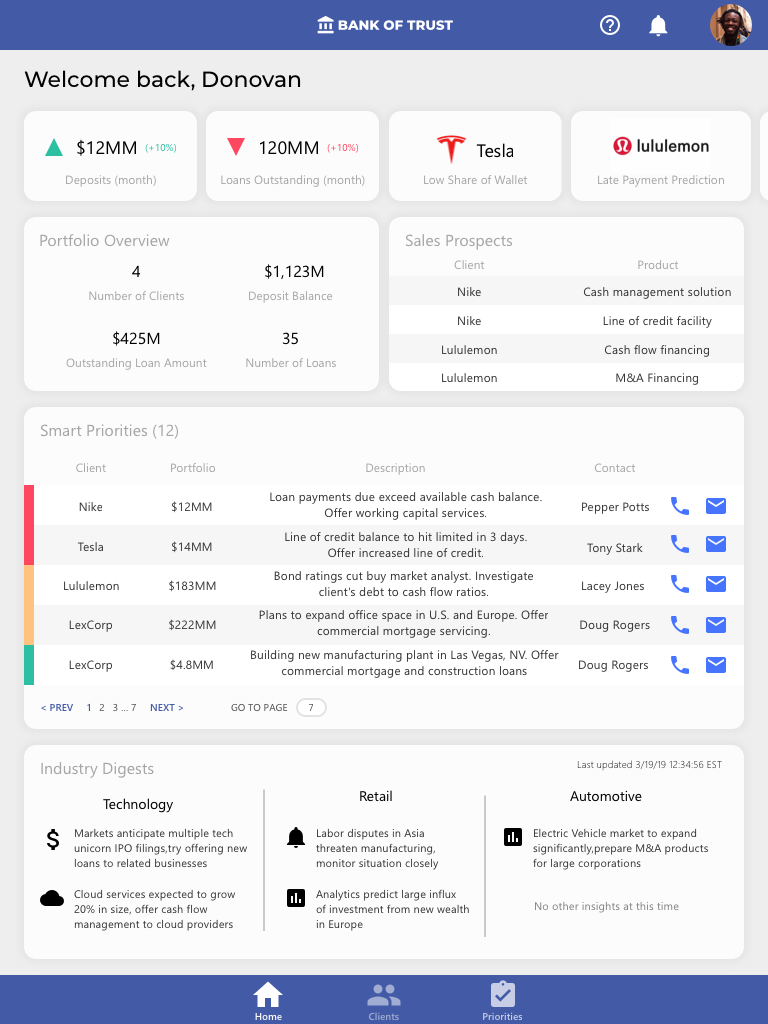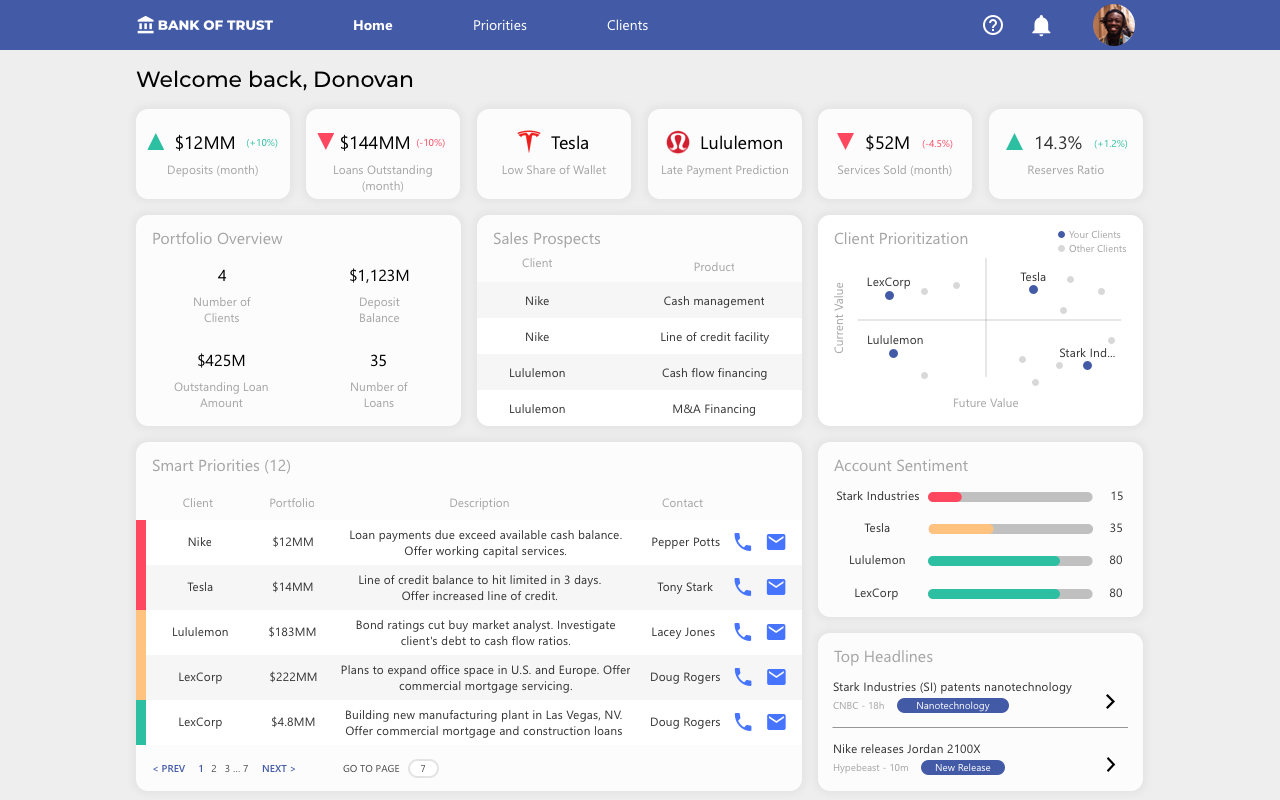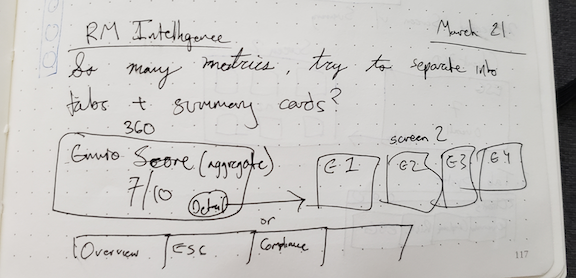Project Role
UX Researcher & Designer
Date Completed
March 2019
Skills Used
Research, Wireframing, UI Design, Information Architecture
In the age of big data, every industry is investing in artificial intelligence and data-driven insights. Corporate banking is no exception. For this project, I was approached by a client to help visualize how AI might be implemented into an advisory tool for relationship managers (RMs), people who are employed by banks to foster a relationship with their clients.
Among corporate banking clients, there is a desire to have more customized advice and products based our their own complex financial situation. While an AI-based solution can process and analyze the massive amounts of information produced about a company, the pressure is still on for an RM to drive the sales of products and provide the human element to their relationship.
Due to the circumstances of this project, I was unable to meet with an RM directly. However, I was able to speak with subject matter experts with backgrounds in corporate banking and had experience working alongside RMs. Each RM tends to work with one or two clients due to the amount of duties they have to perform.
While committed to their clients financial wellbeing, they need to prioritize their financial institution's prosperity. Many of the products sold to clients are loans, lines of credit, and general financing. Because financing provided is normally in the millions of dollars, it's important to ensure that payments are made on time and in the right amount. Furthermore, they're often stuck doing paperwork or reading industry digests. This reduces their sales effectiveness and limits them to a mostly reactionary role.
Furthermore, I decided to do my own research regarding corporate banking trends and relationship manager duties. I found that technology is continuing to make its way into the financial sector, and that even age-old industries are recognizing the value of innovation and change. While this only confirmed what this project was seeking to do, it also informed me that corporate banking is slower to change, and that all examples that we find in consumer grade applications may not suit the needs of RMs. While I could incorporate elements like better navigation, I knew I had to keep familiar elements and interactions to avoid alienating users.
While using second hand information is not ideal, it provides a better starting point than not having anything at all. Throughout this process, I made sure to verify my assumptions with financial experts so that I continued to design with the proper mindset.
With the information that I had discovered, I decided to pursue a dashboard design. I found that dashboards were tools they were familiar with, and I believed the capabilities they provided such as performance monitoring, notifications, and data displays, would be similar to other tools used and as well as fulfill the needs of an RM.

In the top row, relationship managers can see dynamic metrics generated by AI that change depending on what's most relevant at a given time. These KPIs were validated by financial experts and give an RM at-a-glance measure of the health of their portfolio. While the AI normally suggests actions to take, an experienced RM can act on their own if they notice a sizable dip in their metrics.
Below that, there is a summary card about the RM's portfolio. This was an ask from the client, as these statistics provide a quick description of the assets within an RM's portfolio. Alongside that, there is a table of Sales Prospects that plainly lists out suggested products for clients based on clients own financial data as well as predictions based on past situations. By keeping sales prospects visible, they act as a goal for an RM to target and fulfill. These support some of the Smart Priorities listed below, which have more detail into the why a sale might be proposed.
The Smart Priorities table incorporates AI-based recommendations by monitoring news, financials, and various other data sources. These priorities are based on urgency (indicated by color). For these priorities, an RM must contact the client, whose email and phone communications are accessible directly in the table. In addition to being generated automatically, they are also completed automatically based on the actions the RM takes.
The final row of this dashboard offers an industry digest view. This section, once again powered by AI, offers advice and summarizes trends based on multiple data sources about industries an RM is involved in. While these insights support the sales opportunities in the Smart Priorities table, they also offer the background behind what the AI is recommending, and why. This section frees up the time an RM would normally have to take to find their own material, read it, and analyze it on their own. Because the amount of data analyzed is so much more than a single person could do, it has the potential to offer information that wouldn't be encountered otherwise. This feature in particular will help an RM offer more customized advice and products to a customer. By combining industry trends with a corporations own financial data, an AI can help anticipate what products a client will need. An RM, after conducting a common sense check, can approach a client with tailored advice and products based on these data.
This solution incorporates powerful solutions that go beyond conventional financial planning. AI empowers relationship managers to react in real-time, actively manage their clients, and spend more time creating value for them and their clients.
Relationship managers are often travelling from client to client, meaning they don't always have access to their laptop or desktop computers. With this in mind, I created designs for mobile, tablet, and desktop form factors. In addition, I wanted to ensure each form factor maintained full functionality of the application, which required some adaptations.
To fulfill the goal of being responsive, I opted to use cards as they scale easily from small form factors to larger ones. In addition, they also naturally divide information into more digestible chunks, allowing me to separate information more easily.
Adapting the Smart Priorities table was a challenge. Because Smart Priorities are a major feature in driving sales, they have been placed under their own tab to represent a major functionality of the application. I played around with the idea of shrinking the table and making it scroll left to right, but I realized that it was difficult to see the full description of the priority, and scrolling left to right isn't an optimized action for mobile users. I instead created a list, which still fulfilled the purpose of the table, but in a more mobile friendly way. In addition, I still included quick access to the call button by swiping left on the list item. This feature allows advanced users to take a shortcut, but doesn't put a burden on learning hidden interactions.


To demonstrate the full experience an RM would have I also designed for a larger form factor, such as a laptop or a desktop computer. This design utilizes the full space available, but still opts for an information dense display that creates a sense of cohesion between the different views of the application.


As this project continued to receive feedback, additional features were proposed and previous features were either removed or tabled for later discussion.
This lead to multiple revisions which sometimes overrode what I was told in the meeting previous. I spent a lot of time reorganizing the application, sketching out solutions and quickly verifying my assumptions with the client or my fellow designers.
Because so much functionality was up in the air, it was important to not become attached to a certain idea or way of doing things. By quickly testing and iterating, I was able to tear myself away from ideas I found safe and instead moved toward more innovative and ultimately better designs.


Because this project is mostly setting a foundation for a larger product, there was a lot of ambiguity surrounded what this application needed to do and how it should do it. Furthermore, with limited access to actual relationship managers, there was a lot of guesswork involved in designing. While this was uncomfortable, by using best judgements, learning more about the industry, and quickly iterating, I was able to overcome and create designs that provided value. With these strategies moving forward, I know that whenever I face a situation where information isn't readily available, there are ways to still create useful designs.
While I've done responsive design before, each project is still a test of technical skills and content first planning. By designing for all multiple form factors, I continue to develop not only my design skills but also planning and concepting as well.